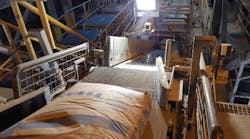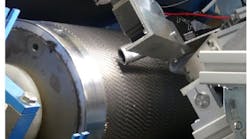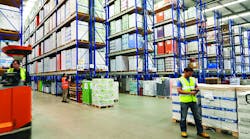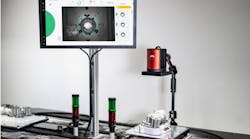PRESS RELEASE 3-D machine vision is at the start of an extremely fast development, as will be seen at the international trade fair for automation and mechatronics, AUTOMATICA 2010, at the New Munich Trade Fair Centre, 8-11 June 2010. Machine vision systems have achieved notable successes in very different industrial user branches over the past years and developed into a far-ranging system world. The technologically simpler 2-D systems and vision sensors still dominate. However, 3-D applications are clearly on the advance in machine vision. Patrick Schwarzkopf, head of the VDMA Machine Vision group, supported that with figures: "According to our market analysis, already 10% of overall industry sales are handled solely with three-dimensional measurement tasks – with an upward trend! Additionally, there are the already existing applications in automation. Consequently, it is going to be very exciting at AUTOMATICA 2010, because a lot of innovations are going to be presented in the 3-D area." Dr. Olaf Munkelt, CEO of VDMA Machine Vision and Managing Director of MVTec Software also believes that it is clear that, "3-D vision is at the start of an extremely fast development. The merging of machines and machine vision technologies is foreseeable." MVTec is an international software manufacturer for machine vision. Seeing in three dimensions is a necessity for many tasks. This concerns both the people as well as the industrial world and machines. Three-dimensional information will make it possible to master tasks in mechanical engineering and industrial production, for which conventional 2D technologies are not sufficient. The reason for this is that orientation must be given to detect objects with 2-D technologies. On the other hand, 3-D vision can detect objects regardless of their position. The perspective matching can even detect tilted and turned objects unambiguously in their spatial coordinates. As a result, a robot becomes more or less independent with 3-D vision. It sees how a work piece is lying, upright, or hanging and can grab the right item in a targeted manner. 3D vision makes robots more flexible Different options exist in principle for recording three-dimensional data. You can determine the pictures from several cameras (stereometry), or detect two dimensions with one camera and the third using another sensor (for example, a distance sensor). It is also possible to use a line laser, a 3-D laser profile sensor, or a mixture of all these sensors and cameras. The option used depends on the application. In addition to use for measurement tasks–-a very successful application area–-3-D vision is used increasingly in automation, especially in robotics. Robo3DVision, a division of the Polish company AIC, is at home in this sector. For the needs of AIC, developer and manufacturer of quality heat exchangers and supplier of complete solutions, Robo3DVision has developed an Adaptive Vision System I, which is specialized for three-dimensional tube-to-tubesheet welding using robots. The company is going a step further at AUTOMATICA 2010 and is presenting the new Adaptive Vision System II, which makes it possible to control various robot-supported processes (among others, linear welding, assembling, bonding and inspection). Maciej Kaniewski, Team Director at Robo3DVision, explained: "Our AVS is one of the vision-based robot guidance systems, which I believe are the only genuine 3-D vision systems. Such systems scan the scene, find the position of sought elements and generate the path for the robot. They are especially well suited for gripping, palletizing and assembling as well as for the bonding and welding tasks of robots." Thanks to the three-dimensional information, the machine vision system of the robot can identify an object type and detect its position. As a result, malfunction-free handling is guaranteed, an important prerequisite for automated production processes. The future is in simple operation and a high degree of flexibility For robot vision expert Mr. Kaniewski, the future of vision systems is in a high degree of flexibility such as 3-D vision can provide. He argues: "Today, vision systems are mostly specialized for concrete tasks. Each change in process specifications is expensive and time-consuming. This has to change. The solution lies in the direction of 3-D scanners, which can determine the shape, size, position, and orientation of any objects and consequently can be used for different applications." Important prerequisite: Handling robots and vision systems has to be simple. To that end, he believes that a standardized system should be developed on a PC platform, which controls robots and additional equipment such as welding machines, but which also has a command of vision algorithms and implement them. Dr. Olaf Munkelt from MVTec has similar ideas for the future. He explained that "The robots of the future will certainly be integrated devices, in which machine vision, i.e., 3-D vision, and control software are merged. Of course, it is important to increase ease of operation and use integrated development environments. Consequently, many automated processes will run less on PCs in the future and more on energy-saving embedded hardware. For that to become a reality, software companies have to provide standard products that can be used on such systems without conversion work. That will also result in increasingly more inexpensive solutions." AUTOMATICA – Platform for machine visions solutions His partner Dr. Wolfgang Eckstein, also Managing Director of MVTec Software, pointed out the significance of AUTOMATICA for machine vision: "This event is the most important trade fair for automation worldwide and consequently for robotics too. Machine vision is becoming increasingly more important in this market. As a result, we believe that AUTOMATICA 2010 provides an excellent platform to present our products and the possibilities with 3D vision to potential users." The exhibitors of machine vision will exhibit their products and novelties in Halls A2 and B2. Visitors also have the possibility in the "Machine Vision Know-How Lounge" in Hall B1 to discuss with experts from machine vision. Free technology seminars (in German and English) will be offered there in collaboration with the Vision Academy on 9 and 10 June 2010. The topics of the workshops are sensor technology, thermography, intelligent cameras, robot vision, and software. For example, there will be a talk on the 3-D topic, "3D Vision -– robot-guided machine vision optimizes groove process in automobile production," which Jürgen Schlesinger from VITRONIC Dr.-Ing. Stein Bildverarbeitungssysteme is going to hold. Posted by Vision Systems Design
Voice Your Opinion
Voice Your Opinion




